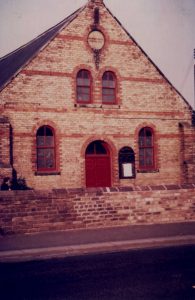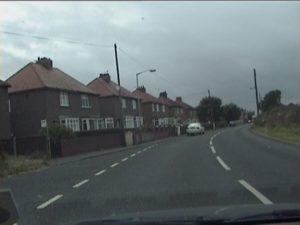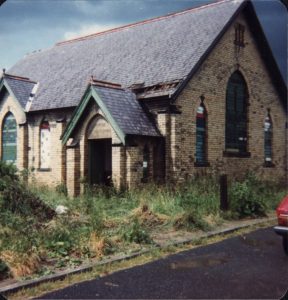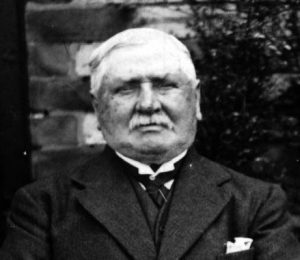
John Luke
John Luke was born on 7th July 1850 in Pittingdon, Durham to mother Jane (Jenny) Luke (1823-1901).
On his birth certificate the name of the father has been left blank, suggesting that John was illegitimate. His mother Jane made her mark ‘x’ being unable to sign her name.
Family story (by John’s grand daughter) has that John was born in the Elvet Workhouse in Durham.
Recently I discovered an amazing fact about the identity of John Luke’s possible father.
Recorded in the Durham Chronicle Newspaper of 27 September 1850, is the startling facts of the charging of William Winter of Pittington with being the father of the illegitimate child of Jane Luke. The hearing was held in the Justice Room, Durham on September 21 before a bench of five justices. It said that Jane Luke had already been before the bench previously trying to get costs from Mr Winter for the maintenance of the child, but being unable to provide evidence (as one of her witnesses didn’t appear) it was dismissed.
Now she was trying a second time, with more evidence, and even though the bench agreed the case should proceed after hearing more evidence, they decided by a majority of three to two no order should be made against Mr Winter as despite the majority being morally convinced that the defendant was the father, he was in office in some religious society, so no order should be made. Astonishing! Poor Jane.
William Winter of Pittington was obviously a well known figure in the community and he was appointed to the Board of Guardians for the Poor for 1849-1850 for the Durham Workhouse. (Durham Chronicle 27 April 1849). There is also a death notice for William Winter of Shiney Row aged 60 years in August 1877.
William Winter was born in 1810 in West Rainton, and married Ann Walker in 1833 in Tanfield, Durham. They had twelve children together, including one (Christopher) who was also born in 1850 in Pittington (like our John Luke), but died that same year either at birth or as a baby.
DNA is amazing how it can confirm family connections, and I’ve found a match with a descendant of William’s brother Thomas (1812-1877), which proves my genetic link to William.
In the 1851 census, John appears aged 1 with his mother Jane, a 28 year old servant to the Nicholson family of Broomside Lane in St Giles, Durham. John’s older brother George Henry b 1847 is already out living with his grandmother Elizabeth Luke (Jane’s stepmother) aged 4.
Head of the household is George Nicholson, a widowed pitman (coal miner), raising his two daughters Ann 8, Elizabeth 4 and son Peter 6.
Ten years later in 1861 John’s mother has married George Nicholson (in 1854), and is the head of the household. Jane had one child with George, Mary Jane Nicholson 1857-1863. Unfortunately her husband George died in 1859, aged only 37.
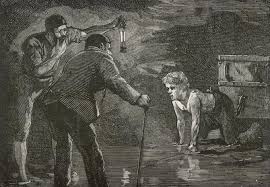
Children in the coal mines Durham England
So Jane is now raising deceased George’s daughter Ann aged 18, a dressmaker, and his son Peter 16.
Also, our John Luke is now 11, his sister Mary Jane Nicholson aged 4, and his brother George Henry Luke aged 14 is now back with them.
All three boys, including young John are already coal miners.
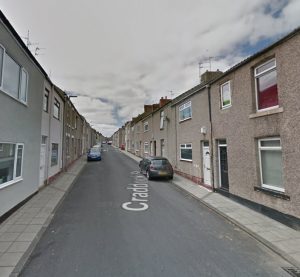
Craddock Street, Spennymoor, Durham
By 1871 20 year old John is living in Craddock Street in Whitworth, Spennymoor with his mother’s second husband Robert Walton, yes another coal miner. Jane had married Robert in 1865. Unfortunately his sister Mary Jane died in 1863 aged just 6.
His brother George Henry has married Isabella Tate in 1863 and then Isabella Marshall in 1891 and is off living his own life. He will go on to have eleven children with two wives. George died in 1927 in Broompark, Durham.
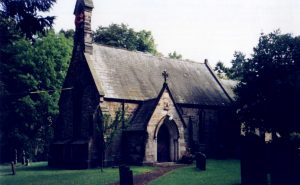
Whitworth, Spennymoor church, Durham
On 12 Dec 1874 24 year old John married Isobella Ritson in the Whitworth, Spennymoor parish church in Durham.
Witneses at the marriage were John’s brother George and Isobella’s father Frank (Francis).
Isobella made her mark ‘x’ as she couldn’t sign her name.
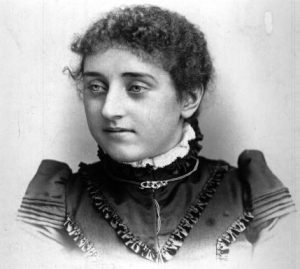
Isobel Ritson
Isobella Ritson was the daughter of coal miner Francis Ritson (1830-1884) and Mary Maddison (1837-1906).
She was born on 22 September 1855 in Crook, Durham and was baptised on 25 January 1857 in Medomsley, Durham. Isobella was one of eleven children.
Isobella grew up in coal mining villages like her husband.
In 1861 she was in Mill Row, Wingate, and in 1871 in Middle Row, Usworth, Durham.
John and Isobella had eleven children –
- 1875 Jane b Spennymoor d 1968 Chevington Drift marr Charles Bryson
- 1878 Mary b Washington d 1950 Penshaw marr George Dean
- 1880 Isabella b d 1964 Balwyn, Australia marr George Gray
- 1883 Newrick b New Herrington d 1912 East Chevington marr Isabella Anderson
- 1885 Francis b Morpeth d 1889 Durham
- 1888 Margaret b Morpeth d 1889 Broomhill
- 1890 Eliza b New Herrington d 1963 Amble marr William Wood
- 1892 Robert b New Herrington d 1965 Cramlington marr Elizabeth Scott
- 1896 Lilian b Durham d 1896 Durham (twin with Mildred)
- 1896 Mildred b Houghton le Spring d 1978 Richmond, Aus marr George Liddle
- 1898 John b Alnwick d 1964 Meadomsley marr Elizabeth Slater
In the 1881 census the family are living in East Row, New Herrington and John and Isabella Luke have their children Jane, Isabella, and George Luke aged 57 a boarder living with them.
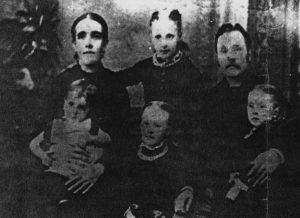
John & Isabel Luke with children Jane, Newrick, Mary and Isobel
In 1891 the family are living at 31 Catherine Terrace, New Herrington. John and Isabella are living with children Jane, Mary, Isabella, Newrick, Eliza and boarder George Wardell.
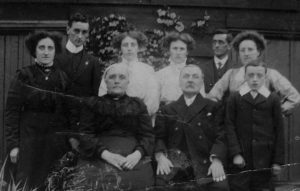
John with Isabel Luke and seven of their children
In 1901 the family have moved to Morpeth, and John and Isabella have Isabella, Neurick, Elizabeth, Robert, Mildred and John living with them.
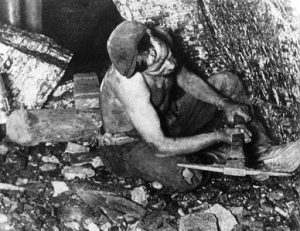
coal miner Durham
John Luke was a hewer in the coal mine. The hewer is the actual coal-digger. Whether the seam be so thin that he can hardly creep into it on hands and knees, or whether it be thick enough for him to stand upright, he is the responsible workman who loosens the coal from the bed.
The hewers are divided into “fore-shift” and “back-shift” men. The former usually work from four in the morning till ten, and the latter from ten till four.
Each man works one week in the fore-shift and one week in the back-shift, alternately.
Every man in the fore-shift marks “3” on his door. This is the sign for the “caller” to wake him at that hour. When roused by that important functionary he gets up and dresses in his pit clothes, which consist of a loose jacket, vest, and knee breeches, all made of thick white flannel; long stockings, strong shoes, and a close fitting, thick leather cap. He then takes a piece of bread and water, or a cup of coffee, but never a full meal. Many prefer to go to work fasting. With a tin bottle full of cold water or tea, a piece of bread, which is called his bait, his Davy lamp, and “baccy-box,” he says good-bye to his wife and speeds off to work.
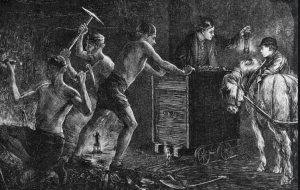
Coal miners Durham England
Placing himself in the cage, he is lowered to the bottom of the shaft, where he lights his lamp and proceeds “in by,” to a place appointed to meet the deputy. This official examines each man’s lamp, and, if found safe, returns it locked to the owner. Each man then finding from the deputy that his place is right, proceeds onwards to his cavel, his picks in one hand, and his lamp in the other. He travels thus a distance varying from 100 to 600 yards.
Sometimes the roof under which he has to pass is not more than three feet high. To progress in this space the feet are kept wide apart, the body is bent at right angles with the hips, the head is held well down, and the face is turned forward. Arrived at his place he undresses and begins by hewing out about fifteen inches of the lower part of the coal. He thus undermines it, and the process is called kirving. The same is done up the sides. This is called nicking. The coal thus hewn is called small coal, and that remaining between the kirve and the nicks is the jud or top, which is either displaced by driving in wedges, or is blasted down with gunpowder. It then becomes the roundy. The hewer fills his tubs, and continues thus alternately hewing and filling. (Durham Mining Museum).
- Broomhill Methodist church
- Broomhill Village
- Primitive Methodist Church Chevington
In 1911 the family are living at 121 Hadston Row South, Broomhill. Living in the 3 roomed house are John and Isabella with children Eliza 21, drapers assistant, Robert 18, coal miner, Mildred 15 at home, John George 13 coal miner, and Henry Laurence Gray, 6, grandson (their daughter Isabella’s child).
In the 1920s John and Isabel lived at No 3, Aged Miners Homes in East Chevington.
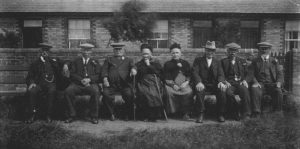
John 3rd from left at Miners Cottages East Chevington 1920
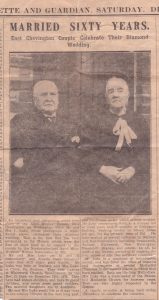
1934 Sunderland Gazette and Guardian Newspaper
In 1934 the couple celebrated 60 years of marriage, their diamond wedding anniversary, and I still have the newspaper clipping saved by Isabel, their daughter. She brought it out to Australia when she immigrated with her husband George in 1911. She also brought her grandmother Isabel’s black silk shawl which I treasure today.
Isabel Luke (nee Ritson), aged 79, died in May 1935 in Broomhill, and is buried in the East Chevington Cemetery.
In her obituary in the local newspaper it stated the late Mrs J Luke of Chevington passed away at the home of her daughter Mr and Mrs Bryson (her daughter Jane and husband Charles), Coronation Terrace, Broomhill after an illness extending some months.
Life long Methodists, Mrs Luke was for years associated with the Wesleyan Methodist Church in Broomhill. The clipping mentions all the children, their grandchildren, nieces and nephews.
88 year old John died in September 1938 at home in Broomhill and he was buried on 30 September in the East Chevington Cemetery.
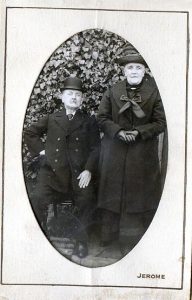
John and Isabel Luke in their 70s

